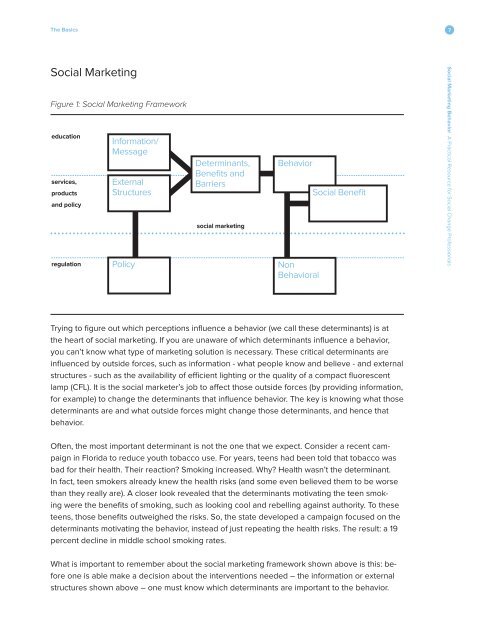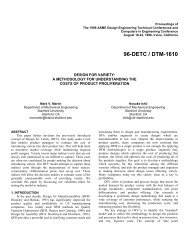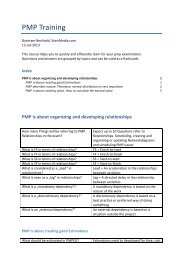Social Marketing
Create successful ePaper yourself
Turn your PDF publications into a flip-book with our unique Google optimized e-Paper software.
The Basics 7<br />
<strong>Social</strong> <strong>Marketing</strong><br />
Figure 1: <strong>Social</strong> <strong>Marketing</strong> Framework<br />
education<br />
services,<br />
products<br />
and policy<br />
regulation<br />
Information/<br />
Message<br />
External<br />
Structures<br />
Policy<br />
Determinants,<br />
Benefits and<br />
Barriers<br />
social marketing<br />
Behavior<br />
Non<br />
Behavioral<br />
<strong>Social</strong> Benefit<br />
Trying to figure out which perceptions influence a behavior (we call these determinants) is at<br />
the heart of social marketing. If you are unaware of which determinants influence a behavior,<br />
you can’t know what type of marketing solution is necessary. These critical determinants are<br />
influenced by outside forces, such as information - what people know and believe - and external<br />
structures - such as the availability of efficient lighting or the quality of a compact fluorescent<br />
lamp (CFL). It is the social marketer’s job to affect those outside forces (by providing information,<br />
for example) to change the determinants that influence behavior. The key is knowing what those<br />
determinants are and what outside forces might change those determinants, and hence that<br />
behavior.<br />
Often, the most important determinant is not the one that we expect. Consider a recent campaign<br />
in Florida to reduce youth tobacco use. For years, teens had been told that tobacco was<br />
bad for their health. Their reaction? Smoking increased. Why? Health wasn’t the determinant.<br />
In fact, teen smokers already knew the health risks (and some even believed them to be worse<br />
than they really are). A closer look revealed that the determinants motivating the teen smoking<br />
were the benefits of smoking, such as looking cool and rebelling against authority. To these<br />
teens, those benefits outweighed the risks. So, the state developed a campaign focused on the<br />
determinants motivating the behavior, instead of just repeating the health risks. The result: a 19<br />
percent decline in middle school smoking rates.<br />
What is important to remember about the social marketing framework shown above is this: before<br />
one is able make a decision about the interventions needed – the information or external<br />
structures shown above – one must know which determinants are important to the behavior.<br />
<strong>Social</strong> <strong>Marketing</strong> Behavior A Practical Resource for <strong>Social</strong> Change Professionals

















